 All Our Tours
All Our Tours
Written by: Vicky Nguyen
Updated date:09/01/2025
Hello, I’m Vicky! As a passionate travel enthusiast and tour planner at Asia Viva Travel, I’ve gathered extensive experience traveling across Vietnam and other captivating destinations in Southeast Asia. Now, I’m thrilled to share these adventures with you through my blog. From my journeys, I’ve gained a deep understanding of the unique cultures, hidden gems, and unforgettable experiences that this region has to offer. My goal is to bring you authentic and practical insights to help you design your own remarkable adventures. Join me, and let’s discover these extraordinary places together!
Contents
The Angkor temple complex was recognized by the United Nations Scientific, Educational and Cultural Organization as a World Cultural Heritage in 1992. So what attracts thousands of tourists to visit the sacred temple of Angkor Wat?
Angkor Wat temple, Cambodia is famous for tourists who love culture, especially Asian culture with Hindu and Buddhist religious cultures. Originally designed to worship Hinduism, but later due to the introduction and strong development of Buddhism, Angkor Wat was converted to worship Buddhism. This could explain why Angkor Wat is a special and interesting blend, expressing the sacredness of these two religions, creating a famous Angkor Wat as the largest religious monument in the world.
The Angkor temple complex has over 1,000 temples of different sizes and shapes bearing Khmer architectural style. Famous temples are Angkor Wat and Angkor Thom, Bayon temples with countless sculptural decorations.
With the massiveness of the small temples scattered around the Angkor Wat area, visitors will feel like they are lost in a large stone maze, but the interesting thing that makes the visitor’s experience more special is that every small corner at Angkor Wat contains the beauty of culture, art, and architecture. The Angkor complex is influenced by ancient Khmer art with a unique architectural style, highlighting Khmer artistic values. The entire architectural complex is outstanding, unique in ancient sculpture and still retains ancient traces with many stone carvings such as giant reliefs, columns, doors, ceilings, walls, corridors, railings, roofs…, all exuding the extraordinary skillful hands of the ancient Khmer people.
To reach the top of Angkor Wat, visitors need to climb 350 steps but Angkor Wat is the most magnificent temple in the entire complex with the main entrance facing the west, straight towards the sunset.
The majestic Angkor Wat at sunrise, showcasing its iconic silhouette and serene reflection in the surrounding moat.
Angkor Wat has 398 rooms, connected by 1,500m of corridors. Above, 5 towers are connected by 3 architectural floors, of which the tallest tower is up to 65m, 4 sub-towers are 40m high. The road leading to the main gate of Angkor Wat is also made of stone blocks, 230m long, nearly 10m wide and 5m high compared to the lake surface on both sides of the temple.
During the entire journey to Angkor Wat and to Angkor Wat temple, visitors will seemingly witness the talent of the ancient Khmer people when the stone carvings decorated with Cambodian religious culture on giant reliefs, columns, doors, ceilings, walls, corridors, railings, roofs… All of these architectures are still preserved to the present so that visitors have the best sightseeing experience.
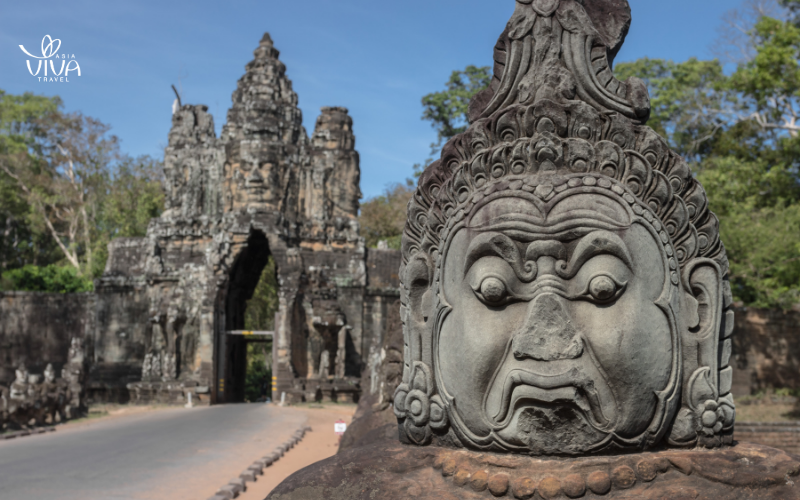
Intricate stone carvings at Angkor Wat, depicting Hindu mythology and Khmer artistry
Located 6km from Siem Riep, it will take about 45 minutes and traveling by car will be the most convenient. In addition, if visitors stay near Angkor Archaeological Park, it is recommended to choose to travel by taxi or tuk-tuk, both of which offer door-to-door service, making it convenient for sightseeing trips.
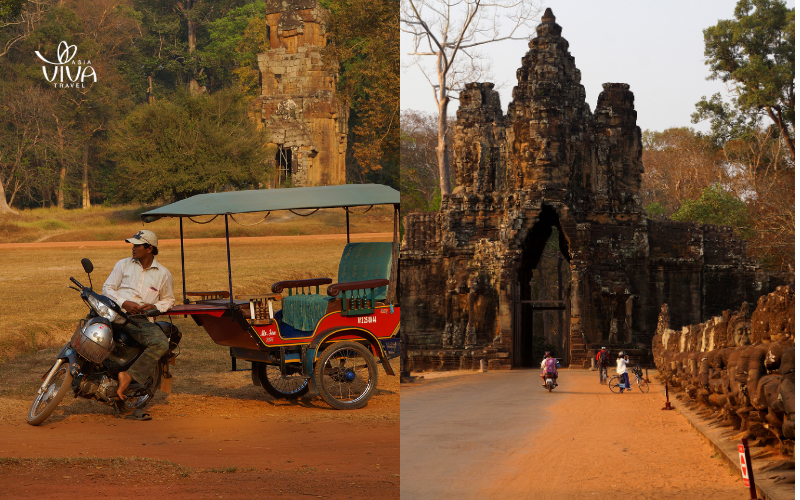
A tuk-tuk waiting at Angkor Archaeological Park, offering visitors a convenient way to explore the complex
In case visitors travel from Phnom Penh – the capital of Cambodia, tourists will travel about 320 km north to Siem Reap city, where Angkor Wat is located. There are a few means of transport that you can choose:
To have a complete visit to Angkor Wat, which visitors can spend time observing and enjoying the surrounding natural scenery, consider spending about 2-3 hours because Angkor Wat has an area of quite big and many small attractions.
For some spiritual sites such as Angkor Wat, visitors should carefully prepare about clothing before visiting to show respect for the sacredness:
The best time to visit Angkor Wat is during the dry season, which runs from November to April next year. More specifically, from November to January of next year offer the most comfortable weather, with average temperatures around 20°C. This cooler climate makes exploring the temple complex much more pleasant and enjoyable. As April comes, the temperature will increase as it marks the transition into the hotter summer months, the temperature will be quite high.
During the rest of the year, visitors can still visit and admire the beauty of Angkor Wat, however remember that during the rainy season there may be floods in Cambodia and Angkor Wat might be affected. The rainy season in Cambodia will fall from May to October.
It’s better for visitors to visit Angkor Wat at sunrise when it’s cooler but crowded, or at lunchtime when most of the tour groups are in town. It is also popular at sunset when the temple can develop a soft glow in the warm light of the late sun. Angkor Wat temple ruins open to welcome visitors quite early, from 5:00 a.m. and will close at 5:00 p.m.
The price for an entry pass to the temples of Angkor costs US$37 for one day, US$62 for three days (which can be used over a period of 10 days), and US$72 for one week (which can be used over one month).
Day 1:
Day 2:
Day 3:
For more information: https://asiavivatravel.com/explore-mysthique-angkor-legendary-mekong-in-9-days
Angkor Thom has outstanding temples and architecture such as Bayon Temple, Baphuon Temple, Phnom Bakheng Temple on the top of the hill, Elephant Terrace, Terrace of the Leper King and 5 large gates leading to Angkor Thom. In which, Bayon Temple gives visitors the most impressive feeling, they are completely conquered by its exemplary and lively beauty. The temple is made up of 50 stone towers. Its core is a terraced architectural complex with 16 medium-sized stupas and many small, interconnected stupas.
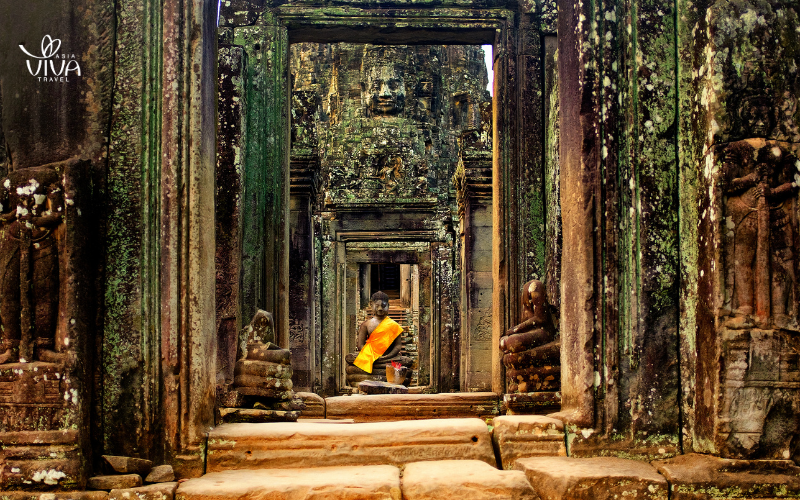
A quiet moment at Bayon Temple, featuring the serene stone faces of Avalokiteshvara
Unlike Angkor Wat, Angkor Thom has a more vivid beauty when besides the stone carvings with ancient Khmer architecture, there are also statues of gods worshiped by people in this temple area. Visitors can learn more and see the majesty of the gods worshiped in Cambodia, see the respect of the Cambodian people for the gods. For this reason, Cambodia is one of the interesting destinations for spiritual tourism and exploring the culture of Southeast Asian countries in general.
One thing that tourists find quite strange at Angkor Wat temple is that there are very few trees to provide shade, most of them are large trees scattered around the area with large roots sticking out of the ground. Standing out in the Little Circuit area – this area has the most famous temple, the “ancient tree” temple Ta Prohm. The branches and roots of the ancient trees grow intertwined, covering the temple, creating a strange scene, attracting tourists to travel to Cambodia.
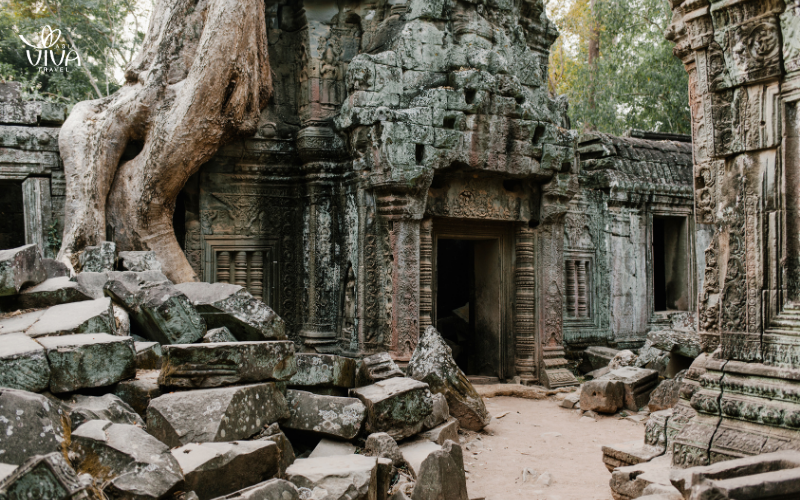
Ta Prohm Temple, where ancient trees intertwine with centuries-old ruins, creating an enchanting scene
The Big Circuit includes several remarkable sites, with Preah Khan Temple being a standout. This ancient temple, similar in structure to Ta Prohm, is adorned with stone walls intertwined with the roots of centuries-old trees, creating a wild, majestic setting that transports you back to an ancient world. The Big Circuit is also famous for its ideal sunset viewing spot at Pre Rup Temple. With its vast open space and the golden-orange hues of dusk, watching the sunset here is an unforgettable experience you shouldn’t miss when visiting Angkor Wat.
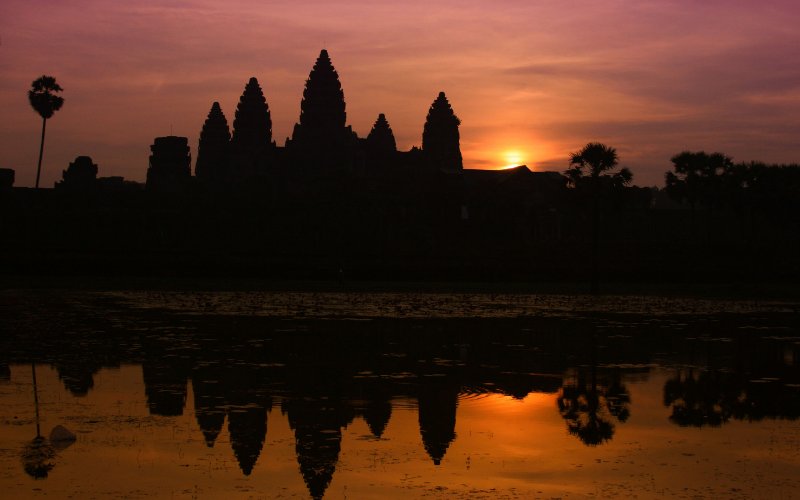
The sunset view from Pre Rup Temple, casting golden hues over the vast Angkor landscape
Besides the above highlights, Angkor Wat also has other small peripheral temples or other tourist areas including ruins from ancient villages, temples, etc.
Angkor Wat (Siem Reap) is truly a must-visit, a place where travelers can experience the profound beauty and cultural depth of ancient Cambodia. Guided by the insights and recommendations from us, Asia Viva Travel, you’ll uncover the breathtaking architecture, intricate carvings, and historical richness that make this site so extraordinary. As you explore, remember to embrace responsible tourism—respect the environment and honor the cultural heritage preserved within each temple. By following these practices, we help ensure that this magnificent site remains a source of wonder for generations to come.
At Asia Viva Travel, we are committed to supporting society, especially in Vietnam’s remote regions. By traveling with us, you help support local tourism workers and contribute to building schools and providing free lunches for disadvantaged children in North Vietnam’s mountains. Join us to help build a better future for Vietnam’s children and vulnerable communities in the “Nuôi em” project .

 26/11/2025
26/11/2025Visiting Cambodia and Vietnam for stunning landscapes, vibrant cities, ancient temples, and UNESCO World Heritage sites is a complete travel experience for tourists.

 19/11/2025
19/11/2025The Golden Triangle is one of the most legendary travel destinations in Southeast Asia, known for its history, stunning river landscapes, and multicultural influence

 30/07/2025
30/07/2025Is Cambodia safe to travel? Yes, Cambodia is a safe and welcoming destination for all tourists. With its vibrant culture, breathtaking natural landscapes, exploring this country is enjoyable and rewarding.

 04/07/2025
04/07/2025Located in Koh Kong province, the Cardamom Mountains are part of Southeast Asia’s largest rainforest, rich in biodiversity and home to rare wildlife and flora.